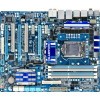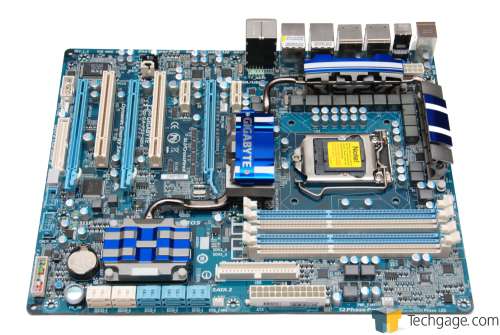- Qualcomm Launches Snapdragon 4 Gen 2 Mobile Platform
- AMD Launches Ryzen PRO 7000 Series Mobile & Desktop Platform
- Intel Launches Sleek Single-Slot Arc Pro A60 Workstation Graphics Card
- NVIDIA Announces Latest Ada Lovelace Additions: GeForce RTX 4060 Ti & RTX 4060
- Maxon Redshift With AMD Radeon GPU Rendering Support Now Available
Gigabyte P55-UD5

Alongside Intel’s Lynnfield launch, Gigabyte launched close to ten motherboards, one of which we’re taking a look at here. The P55-UD5 is the company’s second-highest offering, and it shows, with its huge feature-set, 12-phase power solution, overclocking-ability, robust BIOS, keen design and more.
Page 10 – Power Consumption, Final Thoughts
It goes without saying that power efficiency is at the forefront of many consumers’ minds today, and for good reason. Whether you are trying to save money or the environment – or both – it’s good to know just how much effort certain vendors are putting into their products to help them excel in this area. Both AMD and Intel have worked hard to develop efficient chips, and that’s evident with each new launch. The CPUs are getting faster, and use less power, and hopefully things will stay that way.
To help see what kind of wattage a given processor draws on average, we use a Kill-A-Watt that’s plugged into a power bar that’s in turn plugged into one of the wall sockets, with the test system plugged directly into that. The monitor and other components are plugged into the other socket and is not connected to the Kill-A-Watt. For our system specifications, please refer to our methodology page.
To test, the computer is first boot up and left to sit at idle for five minutes, at which point the current wattage is recorded if stable. To test for full CPU load, LinX is run with 2560MB memory usage for a total of five minutes. During that run, the highest point the wattage reaches on the meter is captured and becomes our “Max Load”.

I admit that these results surprised me a bit. The Gigabyte board costs about $50 more than the ASUS board, so by that logic alone, I’d figure that the P55-UD5 was more robust overall, and would of course result in greater power consumption. That wasn’t at all the case though, as the P7P55D Pro actually drew an additional 17W at full load, and 10W at idle.
Final Thoughts
With the company’s P55 launch, Gigabyte has really impressed. After having used the P55-UD5 more than any other P55 to date, I’m comfortable in saying that top to bottom, this board is quality. Everything from the board design, to the features, to the BIOS, to the overclocking-ability… all top-rate. Even simple things like the 100% vertically-mounted S-ATA ports make a difference to me. If it costs little to implement, then it may as well be… it’s a nice feature.
If you read the previous page, then you saw just how amazing this board is when it comes to overclocking. Regardless of whether you are planning to pick up the ~$200 Core i5-750 or ~$555 core i7-870, 4.0GHz stable overclocks are a real possibility, as long as you have the cooling solution to tackle the heat. I can confidently say that overclocking Lynnfield is much easier than Nehalem, however, so even on a stock cooler, you could expect at least 3.6GHz from any LGA1156 offering.
The question comes down to whether or not you need a $220 motherboard. Back in the day, I’d quickly recommend a quality board at over $200, but nowadays, the value offerings are more impressive than ever. Typically, even if all you want to spend is $150, you’re going to score a board that is feature-packed and overclocks well. Luckily, Gigabyte offers boards for pretty-well any price-range, so there’s one bound to suit you.
As it stands though, the P55-UD5 isn’t at all a bad value. You really do get a lot with this board, including features we didn’t discuss, such as the Bluetooth OS locking system, Smart 6 (six unique features that aren’t exactly important, but are cool) and a huge number of S-ATA and USB ports. I can honestly say that few people are going to be able to take advantage of all the connectivity here, and if you can, I gotta tip my hat to you.
-
Pros
- Great board design.
- Feature-packed.
- Tons of connectivity.
- BIOSes are getting better on Gigabyte boards.
- 100% vertically-mounted S-ATA ports.
- Overclocking is made simple here. 4.0GHz stable on i5-750 & i7-870.
-
Cons
- Price (~$220)? You’ll want to make sure you need all the functionality of this board to make it worthwhile.

Gigabyte P55-UD5
Discuss this article in our forums!
Have a comment you wish to make on this article? Recommendations? Criticism? Feel free to head over to our related thread and put your words to our virtual paper! There is no requirement to register in order to respond to these threads, but it sure doesn’t hurt!
Support our efforts! With ad revenue at an all-time low for written websites, we're relying more than ever on reader support to help us continue putting so much effort into this type of content. You can support us by becoming a Patron, or by using our Amazon shopping affiliate links listed through our articles. Thanks for your support!






